Week 2: WHMIS 2015 also referred to as GHS
1/28
There's no tags or description
Looks like no tags are added yet.
Name | Mastery | Learn | Test | Matching | Spaced |
|---|
No study sessions yet.
29 Terms
WHMIS is a
a comprehensive system for providing health and safety information on hazardous products intended for use, handling, or storage in Canadian workplaces
has aligned with the worldwide hazard communication system known as GHS – the Globally Harmonized System of Classification and Labelling of Chemicals
GHS
the Globally Harmonized System of Classification and Labelling of Chemicals
developed by a United Nations (UN) international team of hazard communication experts.
WHMIS has changed to incorporate the Globally Harmonized System of Classification and Labelling of Chemicals (or GHS) for workplace chemicals.
Aligning with GHS provides many benefits, including:
Hazard classification criteria are more comprehensive which improves ability to indicate severity of hazards.
New hazard classes are included.
Physical hazard criteria are consistent with the Transport of Dangerous Goods (TDG regulations).
Standardized language (hazard and precautionary statements).
Standardized SDS format and more comprehensive requirements.
The main components of WHMIS are the following:
Hazard identification and product classification
Labelling and safety data sheets
Worker education and training
The Hazardous Products Regulations set out
specific hazard classification criteria
If a product covered by the Hazardous Products Act meets the criteria to be included in a hazard class or category, it is considered to be a “hazardous product”.
All hazardous products used in the workplace are covered by the WHMIS regulations, and a WHMIS program, including education and training, must be in place.
Management Responsibilities
Have health and safety policies in place
Orient and train workers to ensure awareness and competence in safe work practice-right to know
Keep records, evaluate the program and take corrective actions
Demonstrate of enforcement of rules
Accountability
Conduct accident investigations
Identify hazards and advice employee accordingly
Participate in program development and implementation
Employee Responsibilities
Report hazards
Report accidents
Follow rules
Undergo training
Participate in program development and implementation
Provincial Legislation includes
WHMIS 2015
Occupational health and safety laws and regulations
Worker’s compensation legislation
Environmental legislations
Sanitation and waste disposal regulations
Transportation of Dangerous Goods regulations (highways)
Federal Legislation includes:
WHMIS- 2015
Transportation of Dangerous Goods regulations (rail and seaway)
Canada Labour code part 2
Canadian Nuclear Safety Act
Canadian Criminal code (Bill C-45- in 2004)
Organizations and supervisors are liable for the acts of their representative Individuals
Municipal Legislation includes:
Fire Codes( based on NFPA codes)
Building codes
Sanitation and waste disposal codes
Laboratory guidelines:
Routine Practices: Routine Practices are a set of strategies developed to prevent of transmission of blood borne pathogens. The focus of universal precautions is on blood and selected body fluids such as cerebrospinal fluid, pleural fluid, and amniotic fluid.
Blood and Body substance precautions: urine, vomitus, feces, or sputum are not controlled under universal precautions, and are instead usually covered under a set of guidelines called body substance isolation. These terms were used earlier now not used.
Standard precautions is a term widely adopted in the United States and convey the same set of principles as routine practices. This is a combination of Universal precautions and body substance precautions.
You will also come across the term ROUTINE PRACTICE: This term is used in Canada and it is a combination of universal precautions and body substance isolation
Routine practices are a set of infection control strategies and standards designed to protect workers from exposure to potential sources infectious diseases.
WHMIS Labels
WHMIS legislation requires that products used in the workplace that meet the criteria to be classified as hazardous products be labelled.
supplier labels are
Required Pieces of Information on a Supplier Label
Each controlled product received from a supplier must have a complete WHMIS label.
If the label is damaged or incomplete the product cannot be used
Controlled products fit into one of the 6 WHMIS classes. Suppliers’ labels must be written in both English and French.
Supplier Labels parts
Product Identifier: Should match the product identifier on the Safety Data Sheet
Signal Word:
Hazard Statements: A phrase assigned to a hazard class that describes the nature of the product's hazards
Precautionary Statements: Describes recommended measures to minimize or prevent adverse effects resulting from exposure
Supplier Identification: manufacturer or supplier address
Pictograms: graphical symbols intended to convey specific hazard information visually.
Workplace Labels
All hazardous material containers in the workplace must be labeled.
This is the responsibility of the employer.
workplace parts are
Product name (matching the SDS product name).
Safe handling precautions may include pictograms or other supplier label information.
A reference to the SDS (if available).
Workplace labels are used when
hazardous materials are produced in the workplace
the suppliers label is missing or illegible
when hazardous materials are poured from one container to the next
Workplace labels are not needed when
poured into a container and it is going to be used immediately, or
under the control of the person who decanted it..
For example, when the person who poured the product into another container will be the only person who will use it, and the product will be used during one shift, a full workplace label may not be required. However, the container must still be identified with the product identifier (name).
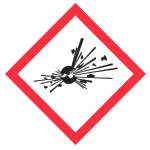
Exploding bomb
for explosion or reactivity hazards

Flame
For fire hazards
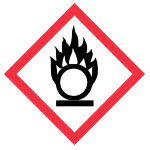
Flame over circle
For oxidizing hazard
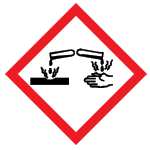
Corrosion
For corrosive damage to metals, as well as skin, eyes
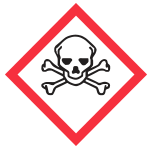
Skull and Crossbones
Can cause death or toxicity with short exposure to small amounts
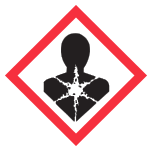
Health Hazard
May cause or suspected of causing health effects
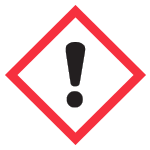
Exclamation Mark
May cause less serious health effects or damage to the ozone layer*
*The GNS system defines an Environmental hazards group. This group (and its classes) was not adopted in WHMIS 2015). However, you may use the environmental classes listed on labels and Safety Data Sheets (SDSs). Including information about environmental hazards is allowed by WHMIS 2015.
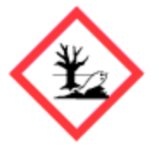
Environment
May cause damage to the aquatic environment
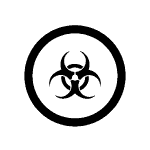
Biohazardous Infectious Materials
for organisms or toxins that can cause diseases in people or animals
Safety Data Sheets (SDSs)
are summary documents that provide information about the hazards of a product and advice about safety precautions
usually written by the manufacturer or supplier of the product
In some circumstances, an employer may be required to prepare an SDS (e.g., when the product is produced and used exclusively in that workplace).
provide more detailed hazard information about the product than the label
identify the hazards of the products you use and to protect yourself from those hazards, including safe handling and emergency measures.
The supplier that must be identified on an SDS is the initial supplier identifier
When is the SDS Updated?
An SDS will be required to be updated when the supplier becomes aware of any "significant new data". (New data regarding the hazard)
will be required to be updated within 90 days of the supplier being aware of the new information
Every SDS must provide a date of last revision in Section 16